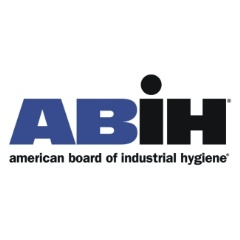National Radon Action Month and Occupational Exposure Risks
The American Board of Industrial Hygiene® (ABIH®) reminds workers and industry of the need to address radon exposure risks in the workplace.
Because one cannot see, smell or taste radon, the only way to know if it’s present in the work environment is to test for it.
The U.S. Environmental Protection Agency (EPA) has designated January as National Radon Action Month. Radon is a cancer-causing radioactive gas that has been found in buildings across the globe. It comes from the natural breakdown of uranium in soil, rock and water and gets into the air people breathe.
Exposure to elevated levels of radon over time may increase a person’s risk of developing lung cancer. The World Health Organization (WHO) has estimated that radon causes between 6% and 15% of lung cancers worldwide.
Radon typically moves up through the ground to the air above and into buildings through cracks and other holes in the foundation. Radon can even enter a building through well water. While exposure to radon in the home is for many their main exposure route, the work environment is also a concern for many employees.
The Agency for Toxic Substances & Disease Registry (ATSDR) lists a number of occupations where workers could be at increased risk of radon exposure. They range from miners and excavators to workers involved with utilities and subway tunnels. The United Kingdom’s Health and Safety Executive (HSE) reports, “Whilst employers who only occupy parts of buildings from the first floor and above are unlikely to have significant radon levels, employers who use cellars, basements and poorly ventilated ground floor rooms are far more likely to have problems with radon levels.”
“The public has grown more aware of radon risks over time, but many people don’t associate it with the work environment,” said Susan Ripple, CIH® and Chair of ABIH®. “Because one cannot see, smell or taste radon, the only way to know if it’s present in the work environment is to test for it. The industrial hygiene community and Certified Industrial Hygienists in particular are well versed in health risk analysis, hazard communication, engineering controls and ventilation, and air sampling and instrumentational analysis to identify, prevent and respond to radon issues in occupational settings. Their knowledge of radiation affords them the ability to anticipate, recognize, evaluate and control radon exposure risks.”
To learn more about the American Board of Industrial Hygiene®, Certified Industrial Hygienist® credential or to locate a CIH® to perform industrial hygiene services, please visit www.ABIH.org, email abih@ABIH.org or call (517) 321-2638.
About the American Board of Industrial Hygiene ®
Since 1960, ABIH®, a not-for-profit corporation, has been the world’s largest organization for certifying professionals in the practice of industrial hygiene. ABIH® is the premier credentialing body responsible for ensuring high-quality certification including education, experience, examination, certification maintenance and ethics enforcement. Currently, more than 6800 people in 31 countries are certified to use the CIH® designation.
( Press Release Image: https://photos.webwire.com/prmedia/12710/201934/201934-1.jpg )
WebWireID201934
- Contact Information
- Paul Cochrane
- President
- Cochrane & Associates, LLC
- Contact via E-mail
This news content may be integrated into any legitimate news gathering and publishing effort. Linking is permitted.
News Release Distribution and Press Release Distribution Services Provided by WebWire.
